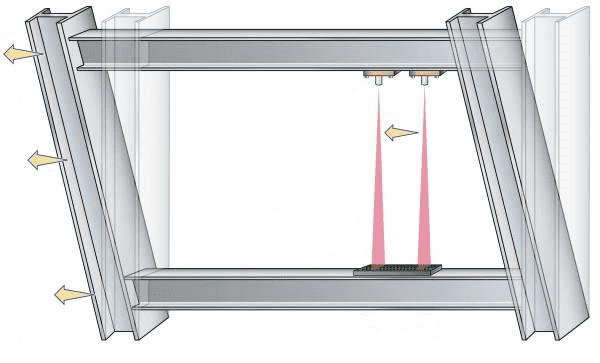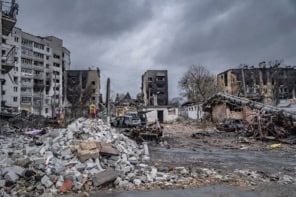
A low-cost, laser-based sensor that can monitor and rapidly assess earthquake damage to a building has been created by scientists in the US. Designed to be installed in multilevel buildings in earthquake-prone regions, the system can determine whether floors in a building have shifted relative to each other. Its inventors say that the device could allow for the rapid assessment of critical buildings like hospitals in the wake of a disaster.
During earthquakes, horizontal ground motions can cause different floors of multilevel buildings to be displaced sideways in relation to each other, a phenomenon that engineers call “interstorey drift”.
Assessing this drift plays a vital role in ensuring that a building is safe to use after an earthquake and to identify if structural repair work is needed. Finding a reliable method to do this quickly and cheaply, however, has proven challenging.
Expensive and time consuming
A traditional approach uses accelerometers that are installed in key points around a building. These determine the forces exerted on the structure during an earthquake and subsequently calculate the extent of drift. This method, however, is time-consuming, impeded by the frequency limitations of the sensors and sometimes unsuccessful in the event of permanent structural damage. Also, accelerometers are expensive to implement on a wide-spread basis.
“Until now, there’s been no way to accurately and directly measure drift between building stories, which is a key parameter for assessing earthquake demand in a building,” explains David McCallen, of the Lawrence Berkeley National Laboratory and the University of Nevada – who led the research.
“The major earthquakes that struck in southern California this [month] serve as a reminder of the risks associated with seismic activity,” notes McCallen. He adds that it is very important to develop “sensors and data analysis that can rapidly measure infrastructure health and inform the most effective response after the next major quake”.
Disaster response
To achieve this, McCallen and his colleagues have spent four years developing sensors that — when placed within a building — can directly and rapidly measure interstorey drift and potentially relay their findings to a disaster response centre.
Their device is called a discrete diode position sensor (DDPS) and works by shining a laser from the ceiling of a room to a sensor pad on the floor. This autonomous detector contains an array of inexpensive, photo-sensitive diodes that can determine, by measuring the displacement of the laser beam, if, by how much and in what direction the ceiling has drifted relative to the floor after an earthquake. From this, engineers can work-out the effect of the quake on the building’s integrity.
“Previous generations of DDPS were quite a bit larger than the system we are now able to deploy,” says McCallen. “Based on design advancements and lessons learned, the sensor is a quarter of the size of our original sensor design, but features 92 diodes staggered in a rectangular array so that the laser beam is always on one or more diodes.”
Shake table
So far, the researchers have only tested the drift sensor in the laboratory, putting the device through its paces in three rounds of trials on a shake table. “The rigorous testing the DDPS has undergone indicates how the drift displacements measured on the three testbeds compared to representative drifts that could be achieved on an actual full-scale building undergoing strong shaking from an earthquake,” McCallen says.

How forests could limit earthquake damage to buildings
In the coming months, the team will install sensors in a multistorey building at the Lawrence Berkeley National Laboratory. The structure is located adjacent to California’s Hayward Fault Zone, which is one of the most potentially dangerous earthquake regions in the US. In the future, the devices could be installed in buildings throughout regions that are particularly earthquake prone. Emerging 5G communications systems could be used to link the sensors to central disaster response centres, say the researchers.
However, McCallen explains, “we also need to have back-up hardened communications in a post-earthquake environment in case existing network connectivity is down, so we envision back-up communications that could blip data through a satellite so that there would be high certainty in the ability to send building response data to remote locations”.
Looking to the future, McCallen adds “We are excited that this sensor technology is now ready for field trials, at a time when post-earthquake response strategies have evolved to prioritize safe, continued building functionality and re-occupancy in addition to ‘life safety’.”



